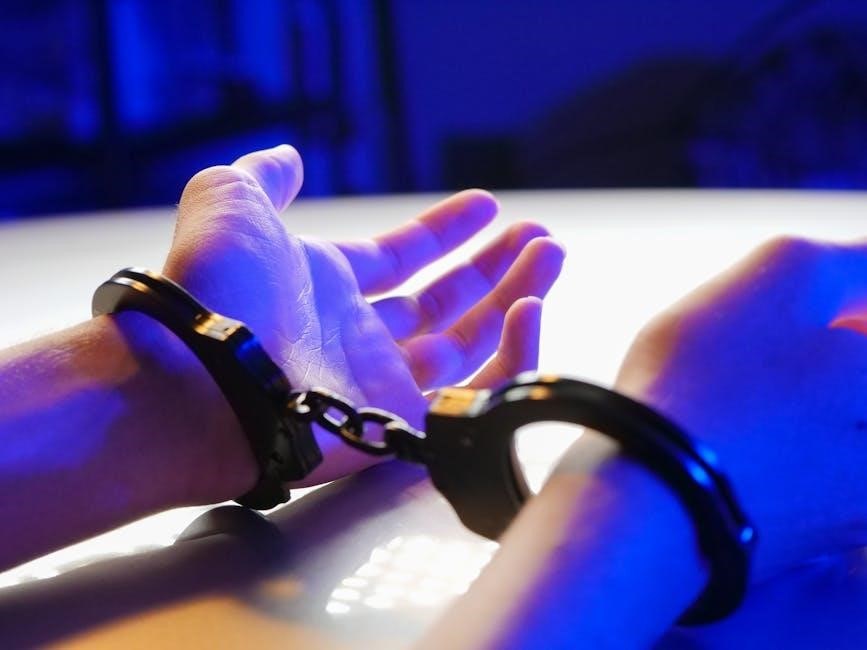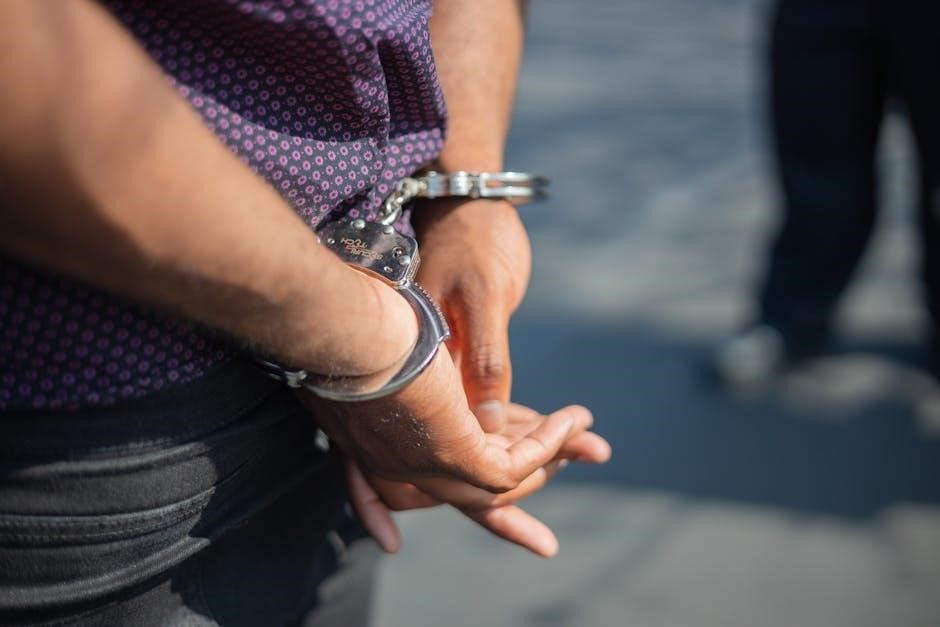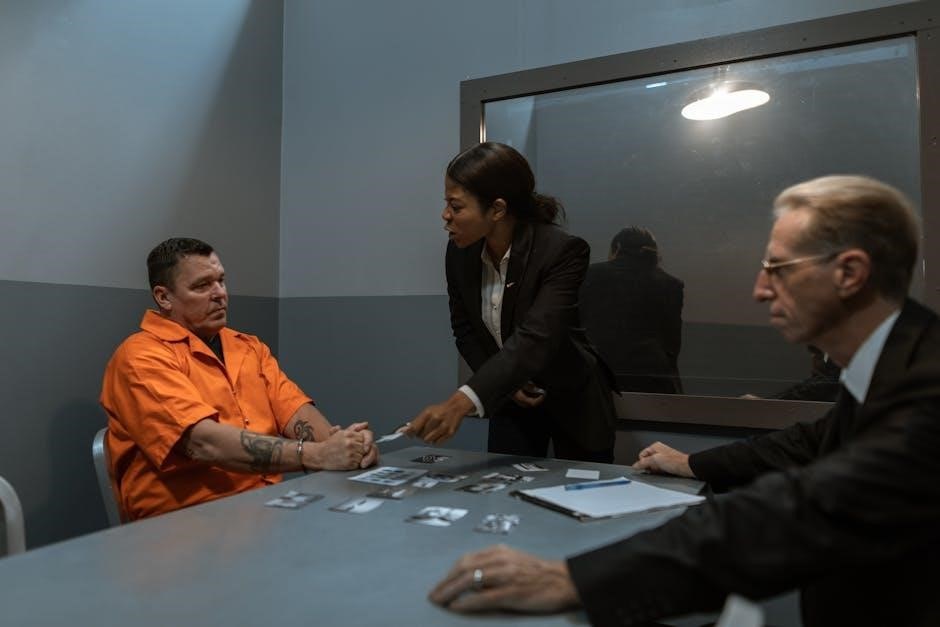The criminal justice system is a complex entity with
various components
and processes that work together to maintain social order and provide justice to victims and offenders alike always effectively.
Overview of the Criminal Justice System
The criminal justice system is a network of agencies and processes that work together to prevent and control crime, while also providing justice to victims and offenders.
This system is composed of multiple components, including law enforcement, courts, and corrections, which all play a crucial role in maintaining social order.
Understanding the criminal justice system requires a comprehensive analysis of its various parts and how they interact with each other to achieve their goals.
The system’s effectiveness is often measured by its ability to reduce crime rates, provide fair and impartial justice, and rehabilitate offenders to become productive members of society.
By examining the criminal justice system from a practical perspective, individuals can gain a deeper understanding of the complexities and challenges involved in maintaining justice and social order.
Structure of the Criminal Justice System
The criminal justice system has a hierarchical structure, with each component playing a specific role in the administration of justice.
At the federal, state, and local levels, there are various agencies and organizations that work together to enforce laws and maintain social order.
The structure of the system is designed to provide a framework for the delivery of justice, with each component building on the previous one to ensure a smooth and efficient process.
The system’s structure is also influenced by the principles of due process and the rule of law, which ensure that individuals are treated fairly and justly.
Understanding the structure of the criminal justice system is essential for identifying areas of improvement and implementing reforms that can enhance the overall effectiveness of the system and promote justice and social order.
This structure is critical to the functioning of the system.

Components of the Criminal Justice System
The system consists of law enforcement, courts, and corrections agencies working together effectively always.
Law Enforcement Component
The law enforcement component is responsible for maintaining social order and enforcing laws.
This component includes local, state, and federal agencies such as police departments and sheriffs’ offices.
Their primary functions include preventing and investigating crimes, as well as apprehending suspects.
Law enforcement agencies also work to build trust and relationships with the communities they serve.
This is achieved through community policing initiatives and other outreach programs.
The law enforcement component is a critical part of the criminal justice system, as it sets the stage for the subsequent components.
Effective law enforcement is essential for ensuring that crimes are properly investigated and that perpetrators are brought to justice.
The law enforcement component must also balance the need to enforce laws with the need to protect individual rights and freedoms.
By doing so, law enforcement agencies can help to maintain public safety and promote a sense of justice and fairness in society.

Courts Component
The courts component is a crucial part of the criminal justice system, responsible for interpreting laws and determining guilt or innocence.
This component includes trial courts, appellate courts, and supreme courts, each with distinct roles and responsibilities.
The primary function of the courts is to provide a fair and impartial forum for resolving disputes and determining the outcome of criminal cases.
Courts also have the authority to review and interpret laws, ensuring that they are consistent with the constitution and other higher laws.
The courts component is composed of judges, prosecutors, and defense attorneys, who work together to ensure that justice is served.
The courts play a critical role in upholding the rule of law and protecting individual rights, and their decisions have a significant impact on the criminal justice system as a whole.
Effective court administration is essential for ensuring that cases are processed efficiently and that justice is served in a timely manner.
The courts component is a vital part of the criminal justice system, and its functions are essential to maintaining public safety and trust in the system.
Corrections Component
The corrections component is responsible for the detention, rehabilitation, and supervision of offenders.
This component includes prisons, jails, and community corrections programs, such as probation and parole.
The primary goal of corrections is to protect society by confining offenders and providing them with opportunities for rehabilitation.
Corrections agencies are responsible for ensuring the safety and security of both offenders and staff, while also providing programs and services to help offenders become productive members of society.
The corrections component is a critical part of the criminal justice system, as it helps to reduce recidivism and promote public safety.
Effective corrections programs can help to reduce crime and improve community well-being, by providing offenders with the skills and support they need to lead law-abiding lives.
The corrections component is a complex and challenging part of the criminal justice system, requiring a balance between punishment and rehabilitation.

Criminal Justice Process
The process involves a series of steps and procedures to ensure justice is served effectively always.
The criminal justice process is a multifaceted system that involves various stages and procedures to ensure that justice isserve effectively.
The process typically begins with the reporting of a crime and ends with the rehabilitation or punishment of the offender.
The criminal justice process is designed to protect the rights of both the victim and the accused, while also maintaining social order.
It involves a series of complex steps, including investigation, arrest, prosecution, and sentencing.
Each stage of the process is crucial in ensuring that justice is served, and that the rights of all parties involved are protected.
The process is governed by a set of laws and regulations that are designed to ensure fairness and transparency.
Overall, the criminal justice process plays a critical role in maintaining social order and protecting the rights of citizens.
The process is constantly evolving to address new challenges and issues.
New technologies and strategies are being implemented to improve the efficiency and effectiveness of the process.
The ultimate goal of the criminal justice process is to create a safer and more just society for all citizens.
Steps in the Criminal Justice Process
The criminal justice process involves several key steps, including reporting, investigation, and apprehension of the suspect.
The next step is the charging and prosecution of the offender, followed by the adjudication of guilt or innocence.
The process also involves sentencing, which can range from probation to imprisonment, depending on the severity of the crime.
Each step is critical in ensuring that justice is served and that the rights of all parties involved are protected.
The steps in the criminal justice process are designed to be fair and transparent, with multiple checks and balances to prevent abuse of power.
The process is governed by a set of laws and regulations that are designed to ensure the rights of the accused are protected, while also providing justice for the victim.
The steps in the process are interconnected and interdependent, and each one builds on the previous one to ensure a just outcome.
The criminal justice process is a complex and multifaceted system that requires careful navigation and attention to detail.

Practical Perspective on Criminal Justice
Examines the criminal justice system from a practical and applied perspective always effectively online.
Applying Theory to Practice in Criminal Justice
The application of theoretical concepts to real-world problems is a crucial aspect of criminal justice, as it enables professionals to make informed decisions and develop effective strategies for addressing crime and justice issues.
Through the use of case studies and scenario-based learning, students can develop a deeper understanding of the practical applications of criminal justice theory, and learn to think critically about the complex issues that arise in the field.
By applying theoretical concepts to practice, criminal justice professionals can develop innovative solutions to pressing problems, and work towards creating a more just and equitable society for all individuals.
This approach also helps to bridge the gap between academic theory and real-world practice, and provides students with a comprehensive understanding of the criminal justice system and its various components.
Contemporary Issues in Criminal Justice
Current issues in criminal justice include policing practices, corrections reform, and the impact of technology on the justice system.
These issues are complex and multifaceted, requiring a nuanced understanding of the social, political, and economic contexts in which they arise.
For example, the use of body-worn cameras by police officers has raised important questions about privacy, accountability, and the role of technology in policing.
Similarly, the growing recognition of the need for corrections reform has led to increased focus on rehabilitation and restorative justice, and the development of innovative programs and initiatives aimed at reducing recidivism and promoting community safety.
By examining these contemporary issues, students can gain a deeper understanding of the challenges and opportunities facing the criminal justice system, and develop a more informed and critical perspective on the complex issues that shape the field.
The study of the criminal justice system is a complex and fascinating field that offers many opportunities for growth and development.
Through a practical perspective, students can gain a deeper understanding of the system and its many components, including law enforcement, courts, and corrections.
By examining the various aspects of the criminal justice system, individuals can develop a more informed and critical perspective on the issues that shape the field.
Ultimately, the goal of studying the criminal justice system is to gain a better understanding of how to create a safer and more just society for all.
This requires a commitment to lifelong learning and a willingness to stay up-to-date on the latest developments and research in the field.
With a strong foundation in the principles and practices of the criminal justice system, individuals can make a positive impact and contribute to the creation of a more just and equitable society.

No Responses